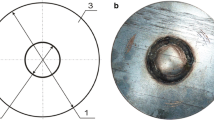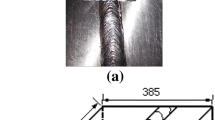Abstract
The results of welding specimens’ stress state studies before and after post weld heat treatment (PWHT) based on the metal magnetic memory (MMM) method are presented. The relationship between variation of the welded joint’s stress state and the intensity of the self-magnetic leakage field formed during welding under the action of a weak geomagnetic field is shown. Quick detection of welded joints stress state inhomogeneity zones by the MMM method and assessment of their variation after PWHT is proposed.







Similar content being viewed by others
Notes
In Russia, for testing by MMM method, special instruments—TSC (manufacturer Energodiagnostika Co. Ltd.)—were certified by the Federal Agency on Technical Regulating and Metrology (the National Standards Body) of the Russian Federation.
References
Vinokurov VA (ed) (1979) Welding in mechanical engineering: handbook, vol 3. Mashinostroyenie, Moscow, 567 p
David Croft (1996) Heat Treatment of Welded Steel Structures. Woodhead Publishing; Revised edition ISBN-10: 1855730162; ISBN-13: 978–1855730168
Hempel N, Nitschke-Pagel TH, Dilger K (2015) Residual stresses in multi-pass butt-welded ferritic-pearlitic steel pipes. Welding in the World 59(4):555–563
Molineroa I, Galernea C, Breugnota JP (1995) Non‐destructive testing of laser welds by Barkhausen noise. Weld Int 9(1):32–35
Kesavan K, Ravisankar K, Parivallal S, Sreeshylam P (2005) Non destructive evaluation of residual stresses in welded plates using the Barkhausen noise technique. Exp Tech 29(5):17–21
Kudryavtsev Y, Kleiman J, Gushcha O (2000) Residual stress measurement in welded elements by ultrasonic method. IX International Congress on Experimental Mechanics, Orlando, pp 954–957
Nitschke T, Wohlfahrt H (1991) The generation of residual stresses due to joining processes. In: Residual stresses—measurement, calculation, evaluation, DGM Informationsgesellschaft. 121–134
Practical Residual Stress Measurement Methods, First Edition. Edited by Gary S. Schajer. John Wiley & Sons, Ltd. Published 2013 by John Wiley & Sons, Ltd.
Russian guiding document GD 153–34.1-003-01 Welding, heat treatment and inspection of boiler tube systems and pipelines during installation and repairs of power equipment (RTM-1s)
Russian code VSN 362–87. 7. Quality control of welded joints.
Antonov AA (2013) Investigation of the residual stress fields in welded structures. Svarochnoye Proizvodstvo 12:13–17
Klyuev VV, Zusman G (eds) (2004) Nondestructive testing and diagnostics: handbook, Revised and supplemented edition, translated from Russian. RSNDTTD and Metrix Instrument Co, Moscow – Houston, 656 pp, illustrated
Gorbash VG, Delendick PN, Pavlenko PN (2011) Nondestructive testing in industry. Magnetic testing. Non-destructive testing and diagnostics 2:48–64
Matyuk VF (2010) Inspection of ferromagnetic products’ structure, mechanical properties and stress state by the coercimetric method / V.F. Matyuk, V. N. Kulagin // Non-destructive testing and diagnostics. 3:1-14
Dubov AA (1997) Investigation of the metal properties using the magnetic memory method. Metals science and heat treatment of metals 9:35–39
Dubov AA (2003) Fundamental distinctive features of the metal magnetic memory method and inspection instruments compared to the known magnetic non-destructive testing method. Control Diagnostics 12:27–29
Vlasov VT, Dubov AA (2004) Physical bases of the metal magnetic memory method. ZAO “TISSO”, Moscow, 424 p
Dubov A, Kolokolnikov S (2008) Quality assurance of welded joints in power engineering by the metal magnetic memory method. Proceeding of the IIW International Conference “Safety and Reliability of Welded Components in Energy and Processing Industry, Graz, Austria, pp 709–714
Dubov A, Kolokolnikov S (2010) Comprehensive diagnostics of parent metal and welded joints of steam pipeline bends. Welding in the World 54(9/10):241–248
Wang ZD, Yao K, Deng B, Ding KQ (2010) Quantitative study of metal magnetic memory signal versus local stress concentration. NDT&E Int 43(6):513–518
Wang ZD, Yao K, Deng B, Ding KQ (2010) Theoretical studies of metal magnetic memory technique on magnetic flux leakage signals. NDT&E Int 43(4):354–359
Roskosz M (2011) Metal magnetic memory testing of welded joints of ferritic and austenitic steels. NDT&E Int 44:305–310
Dubov А, Kolokolnikov S (2012) Assessment of the material state of oil and gas pipelines state based on the metal magnetic memory method. Welding in the World 56(03/04):11–19
Dubov А, Аl D, Kolokolnikov S (2014) Application of the metal magnetic memory method for detection of defects at the initial stage of their development for prevention of failures of power engineering welded steel structures and steam turbine parts. Welding in the World 58(03/04):225–236
Kolokolnikov SM, Dubov AA, Marchenkov AY (2014) Determination of mechanical properties of metal of welded joints by strength parameters in the stress concentration zones detected by the metal magnetic memory method. Welding in the World 58(5):699–706
ISO 24497–1:2007 (2007) Nondestructive testing—metalmagneticmemory—Part 1: vocabulary
ISO 24497–2:2007 (2007) Nondestructive testing—metal magnetic memory—Part 2: general requirements
ISO 24497–3:2007 (2007) Nondestructive testing—metal magnetic memory—Part 3: inspection of welded joints
Dubov AA (2011) Metal magnetic memory method. History and development. FSUE “Izvestiya” Publishing House UD P RF, Moscow, 256 p
Author information
Authors and Affiliations
Corresponding author
Additional information
Recommended for publication by Commission V - NDT and Quality Assurance of Welded Products
Rights and permissions
About this article
Cite this article
Kolokolnikov, S., Dubov, A. & Steklov, O. Assessment of welded joints stress–strain state inhomogeneity before and after post weld heat treatment based on the metal magnetic memory method. Weld World 60, 665–672 (2016). https://doi.org/10.1007/s40194-016-0335-7
Received:
Accepted:
Published:
Issue Date:
DOI: https://doi.org/10.1007/s40194-016-0335-7




